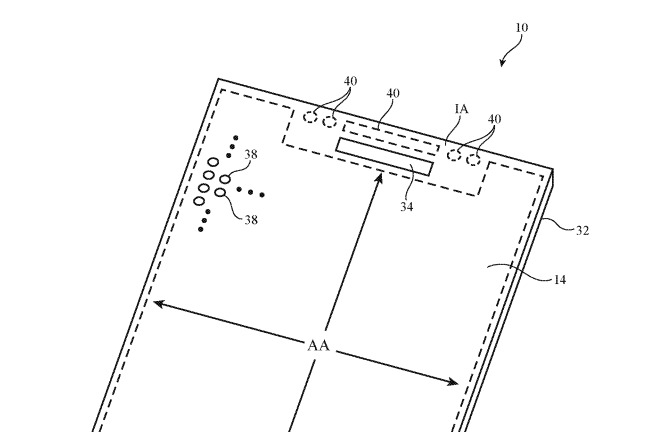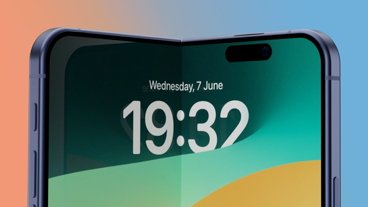Light-emitting elements on Apple devices like the flood illuminator and dot projectors of the iPhone's TrueDepth camera system could benefit from a new diffuser system in the future, one that could switch between different modes by using the same technology that drives liquid crystal displays.
Many electronic devices include lights in various forms and with various purposes, as while some are simply indicators, others could be used as part of a system to complete a task. For example the TrueDepth camera array on the current generation of iPhones uses both flood illuminators and dot projectors to cast infrared light on the user's face, which can then be read by sensors to produce a 3D depth map as part of a Face ID authentication attempt.
Lights used for tasks are usually fitted with some form of optical system that can be used to manipulate the light in specific ways, such as by diffusing it, filtering, or focusing it, depending on what is required for the function. In many cases where light needs to be diffused, a piece of translucent material is simply applied to a surface that the light passes through.
The current methods for diffusing light could be improved, however, with manufacturing defects from bubbles, broken seals, and simply complex product designs could lead to unwanted artifacts and other effects. It is also typically a permanent installation, with no way to disable the diffusion without physically removing the material.
In an Apple patent application published by the US Patent and Trademark Office on Thursday, a filing for "Electronic Devices with Switchable Diffusers" imagines how the use of a liquid crystal material could be used to produce a diffuser that can be enabled and disabled when required.
 An example of the liquid crystal 'sandwich' where it is held inside a sealed container and light is allowed to pass through.
An example of the liquid crystal 'sandwich' where it is held inside a sealed container and light is allowed to pass through. The filing suggests a liquid crystal material can be placed between two substrates, surrounded by spacer walls and a sealant. The substrates can also have electrodes attached as part of a system to activate the liquid crystal held inside the sealed casing.
Much like a liquid crystal display's mechanism, when power is transmitted through the electrodes and through the liquid crystal material, it changes the properties of the material and how it affects light. In its most simplest form, it can prevent light from passing through when activated, and allows passage when not under power.
In the filing, Apple suggests this could make the assembly switch between two states, depending on what is required. For an infrared light source, it is suggested changing the state of the liquid crystal can switch it between a flood illumination mode and a transparent version that allows the light through unaltered.
In the case of the TrueDepth camera, this could result in a dot illuminator passing light through the liquid crystal diffuser without any changes for normal usage, but to switch to a flood illumination mode by activating the layer and diffusing all of the light that attempts to pass through. This effectively could mean that instead of using separate dot projectors and flood illuminators, one component could do both tasks, switching between the two by an active diffusing system.
 An illustration of an 'example device,' indicating the application is for the TrueDepth camera, and possibly sub-display sensor arrays.
An illustration of an 'example device,' indicating the application is for the TrueDepth camera, and possibly sub-display sensor arrays. Apple makes numerous filings with the USPTO on a weekly basis, but while patents and patent applications are not a guarantee that a function or a design idea will appear in a future product or service, it does at least show areas of interest for the company's research efforts.
Refining the components used for the TrueDepth camera is one of the few ways Apple seems to be trying to improve the concept, but one sensor from AMS revealed in January may give it a considerable improvement of removing the famous notch element from the display altogether. The sensor has the ability to pick up visible and infrared light, with the key development being how it can be configured to ignore OLED-produced light, allowing it to be placed invisibly behind the display panel.
Apple has also considered the possibility of reviving Touch ID, the predecessor of Face ID, with patents suggesting the use of an acoustic fingerprint system that turns the entire display into a fingerprint reader.
Controllable filtering could also be of benefit to the sensors used on self-driving vehicles under Apple's "Project Titan." Each vehicle has a wide array of sensors that monitor the road ahead, with such a filter potentially allowing for a reduction in false positives caused through sensors detecting light emitted from the vehicle itself intended for other sensor systems, rather than from its own or directly from the environment.
 Malcolm Owen
Malcolm Owen







-m.jpg)






 Charles Martin
Charles Martin
 Christine McKee
Christine McKee
 Wesley Hilliard
Wesley Hilliard

 Andrew Orr
Andrew Orr
 William Gallagher
William Gallagher
 Sponsored Content
Sponsored Content








4 Comments
Given the level of attention, care and dedication, this will undoubtedly improve gross margins before anything else.
I belive that LG may already have it. If USPTO grands patent then thos might be yet another gap in foolish USPTO patent managment. that is why I say if you do not plan on doing business in the US then ignore USPTO because it needs to be fixed. No such problems with patents in Europe - much healtier system there.